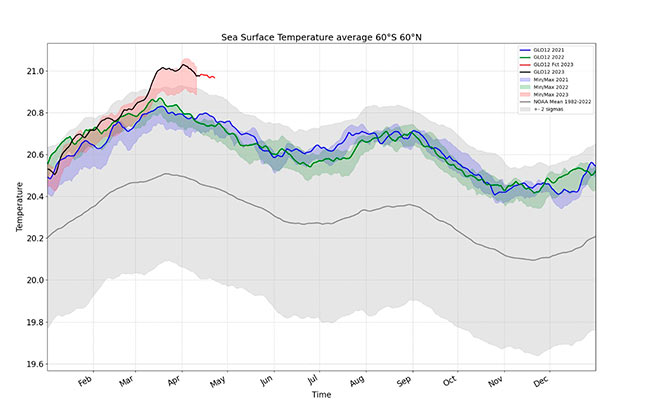The World Meteorological Organization (WMO) is sounding the alarm, noting that there is now a 60% chance of developing an El Niño event from May to the end of July and an 80% chance from July to September.
This is a fluctuation in the temperature of the surface layer of water in the equatorial Pacific Ocean, which leads to the occurrence of catastrophic weather events around the world.
And if the forecasts of dozens of weather stations really come true and the climate phenomenon returns, then we will talk about unprecedented heat waves and, possibly, a new global temperature record.
Increased heat, drought, or rain
Although there is still no clear idea of how strong the El Niño 2023 and how long it can last. Even if we take a good scenario in which the phenomenon is mild, it is still possible that it will affect both temperature patterns and precipitation around the world.
Reference: El Niño (Spanish El Nino – “baby, boy”), or Southern Oscillation – a fluctuation in the temperature of the surface layer of water in the equatorial Pacific Ocean, which has a noticeable effect on the climate. In a narrower sense, El Niño is the phase of the Southern Oscillation, in which the region of heated near-surface waters shifts to the east. The opposite phase of the oscillation is called La Niña (Spanish La Nina – “baby girl“).
“The development of El Niño is likely to lead to a new burst of global warming and increase the likelihood of breaking temperature records,” Petteri Talas, Secretary General of the World Meteorological Organization (WMO), said in a statement.
According to the WMO State of the Global Climate Reports, 2016 was the warmest year on record due to a “double whammy” of El Niño and anthropogenic warming from greenhouse gases.
“The world must prepare for the development of El Niño, which is often associated with increased heat, drought or rain in different parts of the world,” said the Secretary General of the World Meteorological Organization.
“Climate collapse will be widespread.”
Speaking to the media about this phenomenon and how it will affect the planet as a whole, Bill McGuire, professor of geophysics and climate hazards at University College London, says that “the El Niño event will lead to a series of extreme weather events around the planet.”
Most importantly, he said, “Global average temperatures will potentially increase. In particular, over the past five years, the Earth has been 1.1°C to 1.3°C warmer than in the pre-industrial era. However, with the advent of El Niño , global temperatures are likely to rise by 1.4°C or more.”
“It’s dangerously close to the 1.5°C threshold where climate collapse becomes pervasive and invades every aspect of our lives,” says McGuire, noting that the effects of the climate crisis will be impossible to ignore. “From the availability of food and water to the reliability of energy and transport, all of this will greatly affect our daily lives,” he adds.
For his part, meteorologist and director of research at the National Observatory of Athens, Kostas Lagovardos, also argues that the source of concern for all experts is the impact that the El Niño event will have on global temperature. “The new episode is likely to be accompanied by a new record of positive temperature deviations at the global level,” he emphasizes.
However, not all continents are expected to be equally affected by this phenomenon, which occurs in the Pacific. In addition, the impact on global temperatures usually develops within a year of the occurrence of the event, so it is possible that extreme weather events may occur later in Europe than in the summer.
This graph shows the unprecedented increase in sea surface temperature (SST) worldwide.
What will happen in Europe
Scientific studies have shown that during the El Niño-dominated winter months, temperatures are often low in Northern Europe and warmer than usual in the North Atlantic.
Wilfranc Mufuma-Okiya, head of the Climate Prediction Service of the World Meteorological Organization, told the media that what impact this phenomenon is likely to have on Europe.
“In Europe, the impact is more limited in terms of El Niño. However, this phenomenon significantly modulates surface air temperatures in Northern Europe and rainfall in Southern Europe. Thus, due to this phenomenon, winters may be favorable for Europe, but can cause drought in Mediterranean countries.“
For their part, the European Copernicus Agency scientists are awaiting the agency’s updated seasonal forecast for the summer to have a clearer idea of whether there will be any “anomalies” in the weather.
“We expect a seasonal service forecast on May 10. However, we believe that the El Niño event will have less of an impact in Europe than in many other parts of the world. We do not expect an immediate impact of El Niño in Europe this summer, not only because the phenomenon has not yet manifested, but also because the center of action is quite far away, and therefore we will not see its consequences immediately,” says Anka Brukso, chief scientist of the Climate Change Agency’s Copernicus Climate Prediction Group.
Greek researchers, however, are skeptical about how this phenomenon will affect Europe, noting that it may be too early for an early forecast.
“It is not easy to make periodic forecasts of temperature and precipitation trends over several months, such as announcing that Greece will experience extreme high or low temperatures next summer. In addition, climate studies of past conditions show us the average situation in the atmosphere over a long period of time, and not that the same weather conditions that have prevailed for several years will be repeated without change,” says Stavros Dafis, meteorologist and employee of the National Observatory of Athens – meteo.gr.







More Stories
Weather forecast: rain and storms in Athens and Thessaloniki on Saturday
Easter with… umbrellas: unstable weather in the coming days – where will it rain
Thodoris Kolidas explains the phenomenon "black sky" on Good Friday